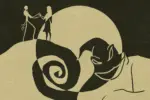TW- death, emotional turmoil
Watching Tim Burton’s “Corpse Bride” as a child absolutely mesmerized me. The movie’s color scheme, meticulously crafted characters, and musical numbers were fascinating to watch.
Though the movie is an animated classic and many viewers opt for a rewatch, it’s becoming more and more obvious that Corpse Bride is a terrific cartoon but traumatizing nonetheless. I did not truly comprehend the gravity of what this film represents, and it would have been jarring had I actually understood.
For many children today, some of the content in this film may not be as suitable as they think. Rather, it is important to understand the topics the film tackles could be triggering. Watching this movie in your adult life comes with a level of self-awareness that makes these hard-hitting subjects hard to miss. From my most recent rewatch it’s clear that this claymation film covers a lot, in a lighthearted way.
Let’s Start From the Beginning
From the beginning of the film, Victor Van Dort and Victoria Everglot are betrothed to one another. Victoria’s marriage to just about anyone with a crumb of status will determine whether her family gets thrown out of their house. Without a marriage, they will be destitute, which puts pressure on Victoria. The forced relationship only favors an otherwise loveless marriage – one that her parents are keen on – making status more important. Despite these circumstances, the pair take a liking to one another and move towards a wedding.
Because of Victor’s nerves and apparent self-esteem issues, the couple’s wedding rehearsal is a mess. He is dismissed to practice his vows alone. Out in the woods, he recites his lines over and over until he gets them right. Part of his rehearsal includes a faux proposal, unknowingly bringing titular corpse bride, Emily, to life. When she rises from the dead, Emily wholeheartedly accepts a proposal that wasn’t directed towards her. Emily’s acceptance is truly where the plot takes off.
Dead or Alive?
As implied by the title, the theme of death should be no surprise to viewers. The most noticeable difference between the living and the dead is the color scheme. The living appear to be gray and glum humans that behave monotonously.
With their mundane actions and dark, depressing hues, it makes for a number of unusual-looking characters that have odd physical characteristics.
Victor plays a dark piano melody entitled “Mysterious, But Poignant Melody.” The title of the melody complements the somber life that the living lead.
Ironically, the dead have mannerisms that are full of life. The characters are painted in colorful hues of warm blues, greens, and purples. The skeletons and corpses seem to be more animated and joyful. This obvious inversion of colors between living and dead is an oxymoron to one another.
The characters are gruesome-looking, with one character’s split skull and another’s body split down the middle, showing their organs. This presentation is exactly what makes Corpse Bride terrific but traumatizing at the same time.
Emily’s backstory is delivered through the musical number “Remains Of The Day.” If the depiction of Emily being tricked, extorted and murdered as a young bride isn’t enough to disturb the viewers, the lyrics really send it home: “Die. Die. We all pass away / But don’t wear a frown ‘cause it’s really okay / And you might try and hide /And you might try and pray / But we all end up the remains of the day.” The harshness and vulgarity of the lyrics are almost comical once you get past what is being sung. It is easier to process death through a fun jazz melody but the theme of death is starkly present.
One of the saddest moments in “Corpse Bride” that I did not initially understand as a child is the conversation between Emily and Victor in Elder Gutknecht’s room. The realization that she is actually “the other woman” and, once again, not a bride dawns on her. During their exchange, he declares that he is promised to Victoria and would never marry Emily.
The pain of this realization leads to Emily’s melancholic song “Tears To Shed”, where she sings of her heartbreak. The song details that despite being dead, she still feels the agonizing pain of receiving no love, with more “tears to shed.”
Barkis Bittern’s character lingers in the back throughout the entire film and is revealed as the culprit behind the person who brutally stole Emily’s life. He is cruel during this scene and rubs in the fact that Emily will forever be a “corpse bride.” From there, everything moves quickly. Barkis accidentally drinks poison and dies. The dead are finally able to bring him to justice. As Victor and Victoria are reunited once again, the viewer’s realize that Emily is still dead and remains alone.
The movie tries to make light of the situation, though it’s apparent that her ending is not so happy. Victor does not marry her; however he frees Emily, transforming her into a thousand tiny butterflies. As the viewer you’re left with the sadness that she never got her happy ending. True to the theme of death and sadness, the “Corpse Bride” does not have a grand finality to it and aids to the realistic aspect of the permanency in death.
The topics of this film are spooky, nonetheless, ranging from something as grim as death to the emotional inferiority that Emily experiences. This film does an excellent job of distracting viewers with unique visuals and catchy music.
While you are being entertained, it’s important to take a step back and process this movie for what it is. Despite the PG rating, this film is considerably too heavy for some kids. With the gruesome mention of death in songs and the depictions of the dead, some of the material can be flagged as inappropriate.
Of course, watching “Corpse Bride” as an adult and being put off from the content may be a personal issue for many. While some children should hold off on running to watch this movie, others being exposed to these real-life issues may have a good time.
Summation
With Halloween time approaching, it might be time for yet another “Corpse Bride” rewatch. As an adult, this time, the movie’s heavier topics will be harder to ignore. The trope of forced marriage, which places a mounting pressure on the main characters, explores the societal pressure that many individuals face. Not to mention the motif of death that is prevalent throughout the entire film, if not the plot’s entirety.
The demonstration and narration that point to the murder of Emily is possibly triggering and is what makes Corpse Bride terrific but traumatizing at the same time. A depiction of this nature may open a can of worms in a conversation that is just too mature for many children. Perhaps this may be the film that helps to introduce the tough topics for your children or siblings as a way to animatedly expose them to these realities. It is important to remember that while this film can be considered an easy watch to some, it might be a hard one to stomach.

















